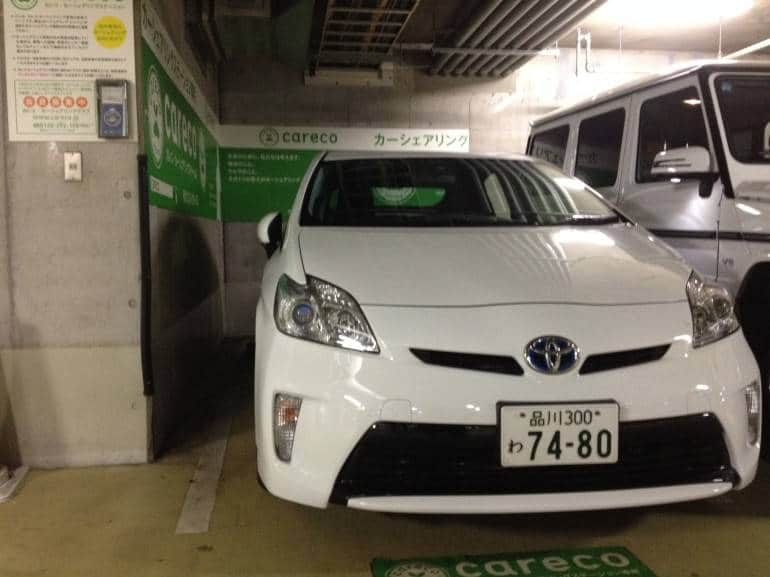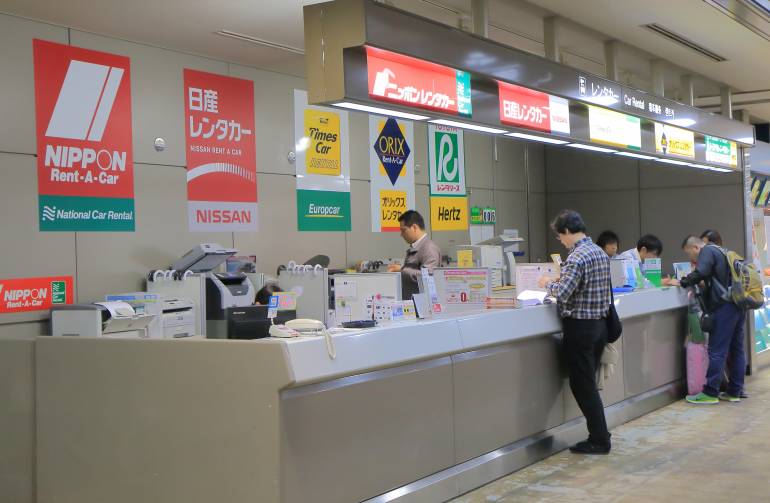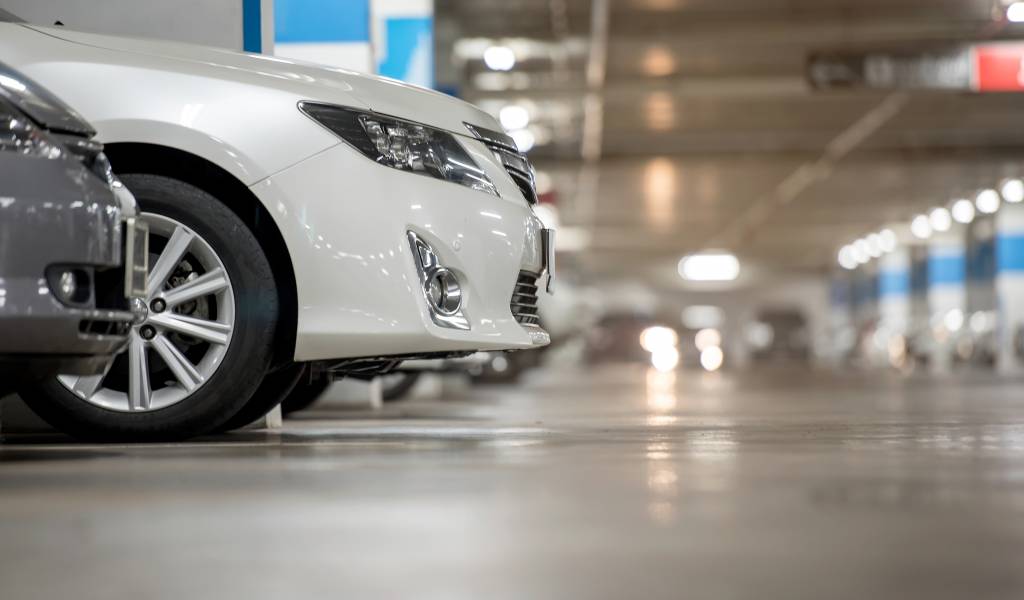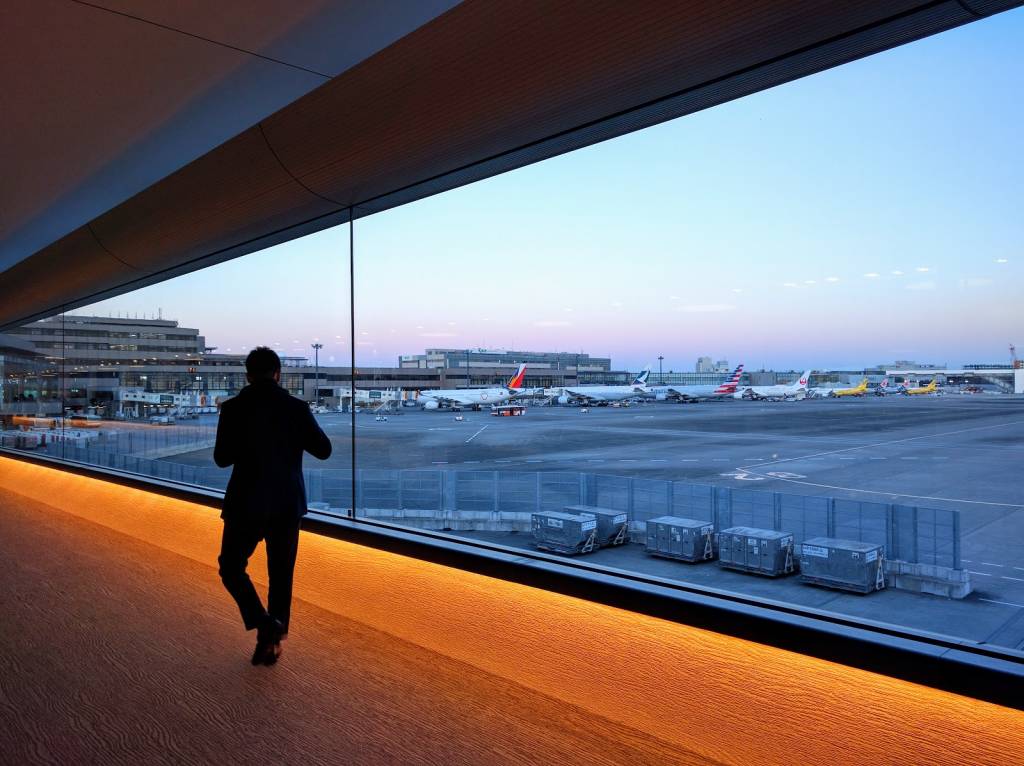For the most part, you probably won’t need to rent a car in Japan—especially not in Tokyo. The trains and buses will get you wherever you want to go, quickly, safely and affordably. That said, there are some occasions when renting a car in Japan is the easiest (or only) way of getting from Point A to Point B.
Car rental in Japan: A few important things to know before you go
Some folks get a bee in their beatnik bonnet about doing the road trip of their dreams in Japan. While you can indeed do some lovely driving in Hokkaido and Okinawa, driving in much of the rest of Japan means rolling along at a relatively slow speed limit (think 80–100km/h) along endless, walled highways. The views are virtually non-existent.
The tolls, well, take their toll on your bank balance (seriously, they can be very steep). The roadside stops are redeeming, to be fair (and there are lots of ’em). But mostly, driving between big cities is a drag. If you had any plans of burning rubber from Tokyo to Osaka, for example, shelve them and take the Shinkansen (or a bus) instead.
Also, parking is really pricey in the cities. If you can find available parking to begin with, it will cost you at least ¥3,000 per day. Consider your cheapo self cautioned! Oh, and before driving anywhere, it pays to familiarize yourself with Japanese road signs. Not all of them are intuitive.

It’s not all cautionary tales though. Japan has an amazing network of rest stops and michi no eki (literally “road station”). As well as providing a breather, you can often pick up local produce at super-low prices or eat local delicacies. Some michi no eki even have onsen, camping grounds, and areas for scenic walks. You’re also (legally protected by law) allowed to sleep in your car at a michi no eki!
Do I actually need a rental car?
If you’re just after a bit of that automotive independence with the wind in your hair and some tunes pumping on the stereo, then just go ahead and rent a car. However, Japan caters amazingly for people without cars—whether you’re a resident that needs to move some stuff or a fresh-off-the-plane visitor.
Most people are familiar with Japan’s impressive Shinkansen trains for high speed travel across the country, and for visitors with a Japan Rail Pass, it’s definitely a more affordable option than driving. Likewise, highway buses can often get you where you want to go in a similar time frame to driving, but for a much lower cost (your trade off in this case is comfort). Within large cities there are plenty of public transportation options to help you get around, and many people find that they don’t need to drive at all.
For residents, one situation where a car might come in handy is for shopping. But even if you need to carry home some bulky purchases like gardening tools, grab a bunch of flat-pack furniture at IKEA, or pick up six dozen bagels from Costco, you can usually get it delivered to your door by the next day for a nominal fee. So why go to the trouble of renting a car?
For certain destinations, such as Okinawa or Hokkaido, it makes a lot of sense to rent a car. Distances are large and public transport is either limited or non-existent. Ditto much of the countryside outside the big urban areas in the rest of Japan.

What do I need to rent a car in Japan?
First off, let’s take a look at your driver’s license. If you have an International Driving Permit (IDP) issued in line with the Geneva Convention, you’ll be able to rent a car in Japan—but not from all companies (lookin’ at you, Niko-Niko).
Booking services such as Kayak, Klook, or rentalcars.com will be happy to help. You can get an IDP through your national automobile association before coming to Japan (note: not once you are here). The permit is valid for a year from the date of issue. You’ll need to carry your local license with you when you use it. You need to be over 18.
If you’re from Germany, France, Switzerland, Belgium, Slovenia, Monaco or Taiwan, you won’t be able to do the IDP thing, but you can use an official Japanese translation of your license instead. You can get the translation done through a private company — it’s easy to order online. Alternatively, you can go through the Japan Automobile Federation or (in some cases) your local embassy or consulate. Once you have it, you can drive for a year after arriving in Japan.
Of course, if you happen to have a Japanese driver’s license, that works too. The other thing you’ll generally need to rent a car in Japan is a credit card.
How much does it cost to rent a car in Japan?
It all depends on what sort of wheels you’re after and how many people you need to pack into the back. In the budget range, a compact car, <1300cc, that can comfortably take four passengers typically costs around ¥7,000 for a 24-hour rental. Bigger and fancier cars usually cost ¥1,500–¥6,000 more. Hybrids can sometimes be had for a competitive price. Toyota rental cars are plentiful. You can also rent luxury and sports cars in Japan, if you’re a classy cheapo.

Rental locations: airport, city or train station?
If you’re a visitor to Japan and plan to spend a few days in Tokyo or Osaka at the start of your trip, picking up a rental car from one of the international airports is a bad idea. Getting around by taxi or train is the way to go in the big cities—it’s cheaper, faster, and more convenient. If you’re heading straight into the countryside, leaving from the airport is practical, but if you’re getting straight off a long-haul flight or you’ve never driven in a left-hand traffic country, you might want to settle in a bit before hitting the highway.
And a word of warning if you’re planning to pick up your car from either central Tokyo or Osaka. Escaping from the big cities can be an ordeal if you’re at all nervous about driving on narrow, heavily congested roads. A large part of Tokyo’s expressway network, for example, is underground with off-ramps branching off from both the left and right and constantly merging traffic.
So while airport and city pick up points might be a rental car user’s first instinct, Japan has a third option: large railway stations. In many areas on the Shinkansen network, train stations are the equivalent of airports. So rather than drive three hours to Nagano, for example, you can take a relaxing trip on a high-speed train, then pick up your rental car right next to the station. View Plaza (JR East’s own travel agency) has packages that include a Shinkansen ticket and car rental. They tend to work with the more expensive rental car companies though, so it’s not always a great deal.
The Japan car rental and return process
Whether you’ve made a reservation online using a booking service like Klook or Kayak, or reserved wheels directly over the phone or via a rental company’s booking site, you simply take your booking details to the designated rental office, confirm your payment information, and away you go. While some Japanese-language ability will make the collection and drop-off of the rental car easier, it’s not essential.

Pick-up
Most of the pick-up procedures are the same as those used anywhere in the world. Usually, it starts with an inspection of the vehicle during which any existing scratches, dents, or damage are noted. Take photos with your phone to document the existing issues.
Ask whether you run on regular or another kind of fuel before you leave the rental car office. “Regular” refers to regular unleaded petrol, “hai-oku” is premium unleaded, and “keiyu” is diesel. Say “Mantan de onegai shimasu” for a full tank of whatever it is you need.
A staff member will sometimes offer you a pack of tissues or a can of (usually cold) coffee as a token gift. Just take it.
Insurance
Before roaring off, it’s worth noting that while rental contracts usually carry some built-in basic insurance, this won’t necessarily cover you 100% in the event of an accident. By paying a bit extra for a collision damage waiver (CDW) and non-operation charge (NOC), you minimize the amounts you might be liable for if something goes awry. If it’s not listed, ask about it. The rental car company might also offer a more comprehensive insurance add-on.
We go into more detail about what to do in event of an accident in the FAQ section below, but we strongly recommend getting a SIM with calling capabilities (most tourist SIMs are data only) so that you can easily keep in touch with your rental car company.

Optional extras
If you have young ‘uns, you can request a baby or child car seat when you make your booking, as well as winter tires, snow tires, snow chains, GPS devices and ETC (electronic toll collection) cards.
If you opt to use an ETC card, you can proceed through toll gates without stopping, and just pay the rental office when you return the car. Otherwise, you’ll need to pay cash at the 一般 toll gates (and yes, they do give change). You should use ETC if available as it’s very convenient.
GPS devices in Japan aren’t great. While some have an English interface and will give you instructions in English, the UI is always arcane, and they’re often out of date. Instead, we recommend using the (much better) turn-by-turn navigation on Google Maps.
Lastly, especially if you’re coming from a warm-climate country, you should take care with your tire selection. Winter tires, snow tires, and snow chains are different! If you’re unfamiliar with chains, make sure you get a demo before you leave. Also a word of advice: If heading into serious snow country, pay a bit extra for an all-wheel drive (AWD) vehicle.
Returning the vehicle
When you’re on your way to return the car, be sure to stop off at a gas (petrol) station (“gasorin sutando” in Japanese) and fill up. This can be quite an intimidating thing to do if it’s your first (or even fortieth) time driving in Japan. To make it easier, head for a regular, staffed gas station rather than a self-service joint. The pump attendants will do all the hard work for you, and even help you get back onto the road. Some rental car companies may provide you with a slip of paper for the gas station staff to complete as evidence that you’ve filled the tank. Gas stations near rental car branches will be very familiar with this slip, so it won’t require any explaining.
A few car rental offices are prepared to do the refueling for you upon the return of the ride, but generally the responsibility is with the driver.
Most rental companies allow you to return the car at a different branch (for a fee), making one-way road trips simple.
If you get stuck in a traffic jam when returning the car and it looks like you might be late in returning the car, you should call the branch immediately. This can be a problem if you’re using a data-only tourist SIM, which is why we recommend getting a SIM with voice calling capabilities.

Extending your car rental
If for whatever reason, you need to extend your rental, you should call your rental company (preferably the branch where you picked up the car) as early as possible. Due to space constraints, many branches keep a small inventory of cars, so there’s a good chance that your car has already been reserved, so be prepared for the rental car to refuse your request. However, if the car is still available, they will confirm the extension with you over the telephone.
Usually, there is a small extra charge for extending the rental, but it should not be excessive. If you are unable to extend the rental on your car, depending on availability, the rental car company may give you the option to return to the branch and swap to a smaller or larger class of vehicle. Whatever you do, don’t call to extend your rental at the last minute when you can’t return the car before the rental deadline as this will incurr penalties. The penalty is calculated differently by each company, but it could be as high as ¥36,000 per day, which might even be charged if you are only an hour late.
Best car rental services in Japan
There are a bunch of different companies serving the vehicle rental market in Japan. To get started we recommend you use the car rental search on sites like Kayak or rentalcars.com. These sites will compare prices for you desired dates, pick up and drop off point across multiple providers, plus you can complete your entire booking in English. Japanese car hire websites are usually a lot less user friendly!
Budget (as in price, not the company) and higher-end cars are available, with plenty of pick-up and drop-off options around major airports and train stations. You should be able to compare prices and book with familiar names like Budget, Avis, Europcar, Toyota, Times and Nissan Rent a Car.
Renting a van or truck in Tokyo
While getting out of Tokyo itself (if you opt for city pick-up) might be a little hair-raising, this is actually a great way to get around the country. You can rent a budget camper van to get out of the hotels and off that beaten track that hipsters seem to hate so much.
If you’re looking to rent a camper van in Japan, we recommend Dream Drive Japan.
The rental car companies also have regular transport vans (like Toyota Hiaces), but you’ll need to go directly to the individual companies to book them. The larger companies like Orix, Toyota Rent a Car, and Nissan Rent a Car are more likely to have vans available. The cost to rent a Hiace-type van is usually about ¥15,000 for 24 hours.
Unless you get a “kei van“, your vehicle will be classed as a mid-sized vehicle, which means your ETC tolls will be higher.
Kei trucks can be rented from about ¥9,000 for 24 hours. With a regular driver’s license, you can rent up to a medium-sized truck—such as the Toyota Dyna. The rental fees are about ¥14,000 per day.
If you need a truck to haul materials from a home center, check with the staff, as many home centers rent out kei trucks cheaply or lend them out free to customers so that they can cart their purchases home.
Alternatives to renting a car in Japan
If you aren’t so keen on the traditional rental business, you can try car sharing instead (note: you’ll need a Japanese license for this). Orix Car Share and other providers allow you to “borrow” their cars, which are parked all over the show, especially in bigger cities like Tokyo and Osaka. You can rent them for short periods of time (even 15 minutes)—making mini, semi-spontaneous (you reserve cars through an app or website) and cheap drives a breeze.
If you can’t or don’t want to drive, you can always take a taxi or use one of the various JR Passes for your escapades.
If you need a car for a specific purpose, but you can’t drive, you can charter a car with a driver. The cost is about ¥33,000 for 6 hours. It seems expensive, but it’s cheaper than a taxi and can be better value if you split the cost with friends or fellow travellers.
Car rental in Japan: FAQs
You ask, we answer.
What are the costs of renting a car in Japan?
Budget around ¥7,000 a day for a cheap rental car—but check prices carefully with the rental company, as they can fluctuate quite a bit depending on the season and demand. Don’t forget that in addition to the rental fee, you’ll be paying road tolls and fuel costs. Depending on whether you’re going on a quick jaunt into the countryside or an epic journey to the far reaches of the country, these additional fees vary from a few thousand yen up to about ¥20,000.
How old do I need to be to rent a car in Japan?
18. And you need a valid license!
What happens if I get a fine or parking ticket?
Take care of it immediately! Follow the instructions carefully. If you’re a resident, be prepared to declare it on your next visa application.
What is the procedure in case of an accident?
If you get into an accident, whether it be with a another vehicle, a roadside ditch, or a wild animal, the first step is to report it to the police, and then call the emergency number for your rental car company. The rental car company will advise on whether to return the car if it is still operable or they will arrange for a tow truck and a replacement. If the car is blocking traffic, the police may forcibly move the car. In all cases, follow the instructions of the police and don’t argue!
Important: Most tourist SIMs are data only and don’t have the ability to call phone numbers in Japan. We strongly recommend that you get a Mobal SIM which is slightly more expensive, but comes with a Japanese phone number and the ability to call other Japanese phones. If you have an accident, and you can’t make a call, you will have to convince a local — or the police — to let you use their phone, and they will not be pleased! See our article on tourist SIMs for more.
Should I rent a car in Okinawa?
Yes. It will make your life on the southern islands much easier. Do it now.
While we do our best to ensure it’s correct, information is subject to change. Post first published in April 2018. Last updated in August 2022 by Maria Danuco.






























